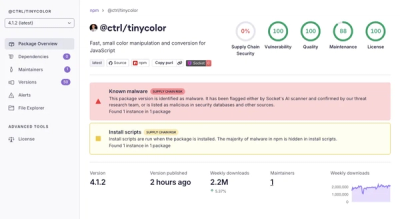Purpose
The Science Design System (SDS) brings consistency and universal standards to CZI’s science products by offering a library of high quality, reusable components that deliver predictable, accessible and easy to learn experiences. Our goal is to democratize access to tools and technologies for scientists.
Design System Documentation
@czi-sds/components implements the Science Design System as documented in Zeroheight. As a result, it's very useful to get familiar with the available theme variables, such as colors, spaces, typography, etc., so you can leverage the theme properly in your application.

Installation
NPM Package
Currently SDS uses Material UI v5
NOTE: Since most of the czi-sds components are built on top of Material UI's equivalent, it's also super useful to use their API documentation to learn about what you can do with the components. Many czi-sds components are style wrappers that pass props through to the MUI component without modifying them.
@czi-sds/components installs without direct dependencies to prevent version errors. Please ensure the following peer dependencies are also installed:
"@emotion/css"
"@emotion/react"
"@emotion/styled"
"@mui/base"
"@mui/icons-material"
"@mui/lab"
"@mui/material"
"react"
"react-dom"
To install @czi-sds/components and the dependencies:
// with npm
npm i @czi-sds/components @emotion/css @emotion/react @emotion/styled @mui/base @mui/material @mui/icons-material @mui/lab react react-dom
// with yarn
yarn add @czi-sds/components @emotion/css @emotion/react @emotion/styled @mui/base @mui/material @mui/icons-material @mui/lab react react-dom
Yarn scripts
Common yarn scrips have been moved to the monorepo root. The -- syntax can be used to pass parameters to the underlying yarn scripts. For instance, to update the snapshots, use lerna run test -- -u instead of running all tests on both packages with yarn test.
-
yarn start: Starts storybook on the local machine
-
yarn build-storybook: Builds the storybook in the docs-build folder
-
yarn test-storybook: Tests current running instance of storybook
-
yarn storybook:axe: Builds the storybook and runs accessibility tests
-
yarn storybook:axeOnly: Runs accessibility tests on the latest build of the storybook inside the docs-build folder
-
yarn test: Runs jest tests
-
yarn namespace-check: Runs typescript type checking on namespace files to ensure that there are no duplicated exports
-
yarn lint: Runs linter
-
yarn build: Build the packages
-
yarn ci: Executes yarn install --frozen-lockfile in both packages
-
To execute any script in the inner package, one can simply use the command lerna run script --scope=<package>. For instance, to run the linter only on the sci-components package, use the command lerna run lint --scope=@czi-sds/components.
Usage
@czi-sds/components comes with five main exports that help you build your app:
- Components - Accessible and reusable components
import React from "react";
import { Button } from "@czi-sds/components";
<Button onClick={actions.onClick} sdsStyle="rounded" sdsType="primary">
{text}
</Button>;
- Mixins - Grouped styles defined by the design system
import { styled } from '@emotion/styled';
import { Typography } from "@mui/material";
import { fontHeaderXL } from "@czi-sds/components";
export const Title - styled(Typography)`
${fontHeaderXl}
// which compiles to:
font-size: 22px;
font-weight: 600;
letter-spacing: 0.3px;
line-height: 30px;
`;
- Selectors - Helper functions that return theme variables baased on passed props
import { css, SerializedStyles } from "@emotion/react";
import styled from "@emotion/styled";
import { getColors, getCorners } from "@czi-sds/components";
export const Tag = styled("div")`
// This is a callback function that returns more CSS rules, but the only way
// to access the custom theme object
${(props) => {
// getColors() is a selector that picks out colors from the theme object
const colors = getColors(props);
// getSpaces() is a selector that picks out spaces from the theme object
const spaces = getSpaces(props);
return `
background-color: ${colors?.gray[500]};
padding-bottom: ${spaces?.m}px;
margin-bottom: ${spaces?.xxl}px;
`;
}}
`;
- CSS & SCSS Variables - Variables for the
defaultTheme to use if your app doesn't support @emotion/styled
@import "~@czi-sds/components/dist/variables";
.button-primary {
background-color: $sds-color-primary-400;
padding: $sds-spaces-xxs;
}
.button-primary {
background-color: var(--sds-color-primary-400);
padding: var(--sds-spaces-xxs);
}
- Tailwind - Tailwind compliant configuration for the
defaultTheme to use if your app uses Tailwind
First you need to import the SDS config into your application's Tailwind config:
const sds = require("@czi-sds/components/dist/tailwind.json");
module.exports = {
mode: "jit",
content: ["./src/**/*.{tsx,scss}"],
theme: {
extend: sds,
},
};
If you have existing styles that you'd like to maintain, you can pick and choose
different parts of the SDS config:
const sds = require("@czi-sds/components/dist/tailwind.json");
module.exports = {
mode: "jit",
content: ["./src/**/*.{tsx,scss}"],
theme: {
extend: {
...sds,
width: {
...sds.width,
"app-modal-width": "500px",
},
height: {
...sds.width,
"app-modal-height": "200px",
},
},
},
};
After that, you should be able to use SDS Tailwind classes in your app:
export function Hello() {
return (
<p className="m-sds-xl px-sds-xs py-sds-s text-sds-error-400">
Hello, World!
</p>
);
}
Default Theme
To use the default theme in your React application, complete the following:
- Add the following HTML to your
index.html at the <head> section:
// installs the sds font from google fonts
<link rel="preconnect" href="https://fonts.googleapis.com" />
<link rel="preconnect" href="https://fonts.gstatic.com" crossorigin />
<link
href="https://fonts.googleapis.com/css2?family=Inter:wght@400;600&display=swap"
rel="stylesheet"
/>
<link
href="https://fonts.googleapis.com/css2?family=IBM+Plex+Mono:wght@400;600&display=swap"
rel="stylesheet"
/>
- Import the default theme object and use it in Material UI's
<ThemeProvier />:
import { ThemeProvider as EmotionThemeProvider } from "@emotion/react";
import { StyledEngineProvider, ThemeProvider } from "@mui/material/styles";
import { defaultTheme } from "@czi-sds/components";
<StyledEngineProvider injectFirst>
<ThemeProvider theme={defaultTheme}>
<EmotionThemeProvider theme={defaultTheme}>
<YourApp />
</EmotionThemeProvider>
</ThemeProvider>
</StyledEngineProvider>;
If you want to override the default theme, please use defaultAppTheme, override the options, and then call createTheme to generate
the full theme object like below. This is needed because createTheme generates
extra theme variables based on the themeOptions provided, so if you override defaultTheme directly, some auxillary theme variables will be based on defaultAppTheme instead of your own custom options
import { ThemeProvider as EmotionThemeProvider } from "@emotion/react";
import { defaultAppTheme, makeThemeOptions } from "@czi-sds/components";
import { StyledEngineProvider, ThemeProvider } from "@mui/material/styles";
import createTheme from "@mui/material/styles/createTheme";
const customTheme = {
...
}
const appTheme = makeThemeOptions({ ...defaultAppTheme, ...customTheme })
const theme = createTheme(appTheme)
<StyledEngineProvider injectFirst>
<ThemeProvider theme={theme}>
<EmotionThemeProvider theme={theme}>
<YourApp />
</EmotionThemeProvider>
</ThemeProvider>
</StyledEngineProvider>
💡 CZGE example available here.
💡 Material UI docs for custom theming available here.
Q&A
-
Why wrapping a component with styled() doesn't style the root element as expected?
This is likely because the component is NOT forwarding the css class name that styled() generates to the intended root element. So we likely need to update the czif component to make it work
For example, if a czif component Foo has the following implementation, styled(Foo) won't style the wrapper <div /> as expected:
function Foo() {
return (
<div>
<ChildA />
<ChildB />
</div>
);
}
The fix is:
function Foo({ className }) {
return (
<div className={className}>
<ChildA />
<ChildB />
</div>
);
}
-
To style a sub-component of a @czi-sds/components component, typically we export the sub-component for the call site to import and style via styled, and then you will be able to pass back the styled sub-component to the @czi-sds/components component through prop
For example, ComplexFilter exports ComplexFilterInputDropdown sub-component, so if you want to style it, you can do the following:
import {
ComplexFilter,
ComplexFilterInputDropdown,
} from "@czi-sds/components";
import styled from "@emotion/styled";
const StyledComplexFilterInputDropdown = styled(ComplexFilterInputDropdown)`
color: pink;
`;
function Foo() {
return (
<ComplexFilter
InputDropdownComponent={StyledComplexFilterInputDropdown}
/>
);
}
Project status
This project is under active development. Contributions and ideas are welcome! If you would like to contribute, check out the contribution guidelines or open an issue.
This project is governed under the Contributor Covenant code of conduct.
Reporting Security Issues
Please note: If you believe you have found a security issue, please responsibly disclose by contacting us at security@chanzuckerberg.com. More information is in our Security Readme
2022 Plans
2022 Plans




